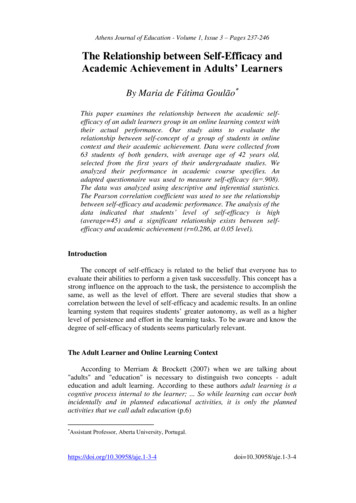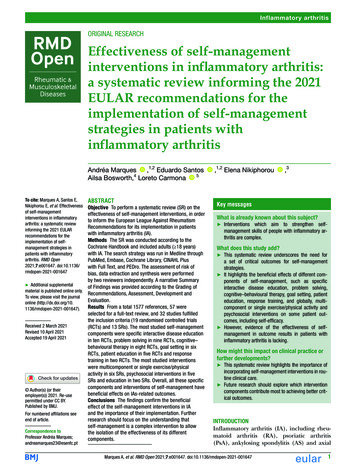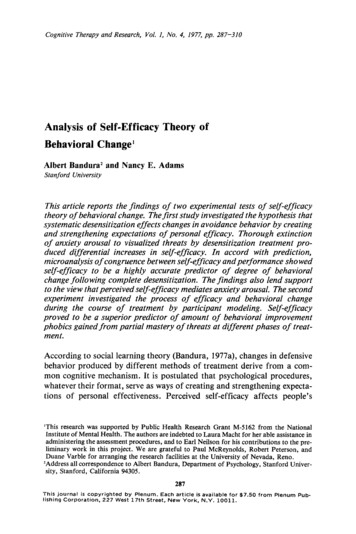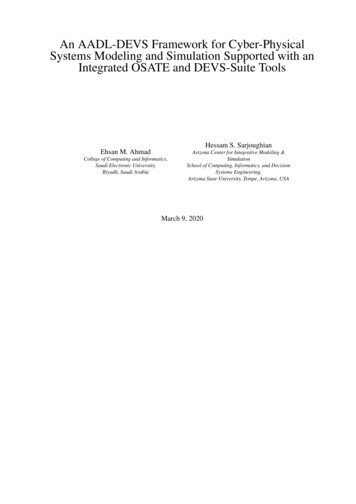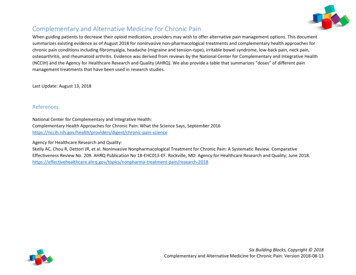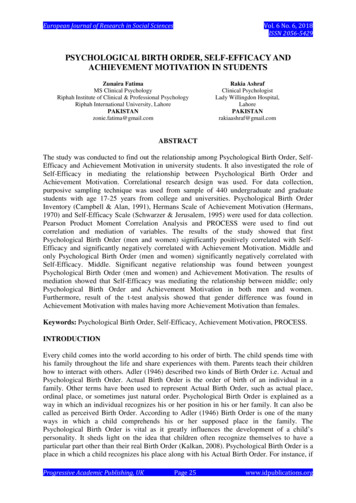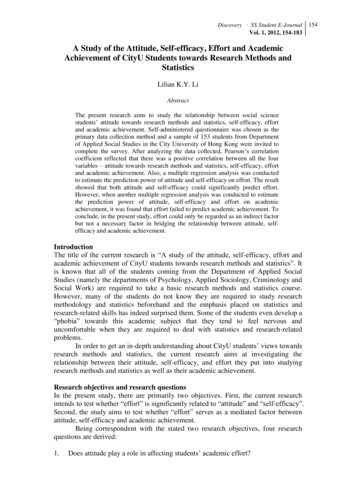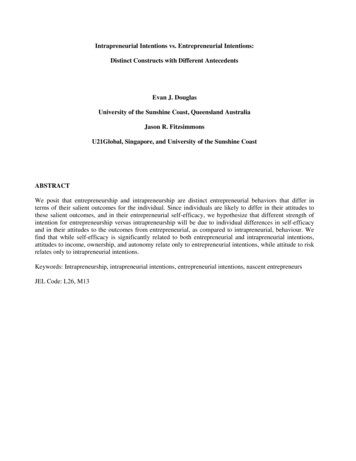
Transcription
JRRDVolume 44, Number 2, 2007Pages 195–222Journal of Rehabilitation Research & DevelopmentEfficacy of selected complementary and alternative medicineinterventions for chronic painGabriel Tan, PhD, ABPP;1–2* Michael H. Craine, PhD;3–4 Matthew J. Bair, MD, MS;5 M. Kay Garcia, DrPH,MSN, RN, LAc;6–7 James Giordano, PhD;8–9 Mark P. Jensen, PhD;10 Shelley M. McDonald, MD;5 DavidPatterson, PhD, ABPP;10 Richard A. Sherman, PhD;11 Wright Williams, PhD;12–13 Jennie C. I. Tsao, PhD141Anesthesiology Care Line, Department of Anesthesiology, Michael E. DeBakey Department of Veterans Affairs (VA)Medical Center (VAMC), Houston, TX; 2Department of Physical Medicine and Rehabilitation, Baylor College of Medicine,Houston, TX; 3Health Psychology, Patient Focused Care Service, Denver VAMC/VA Eastern Colorado Health Care System, Denver, CO; 4Department of Physical Medicine and Rehabilitation, University of Colorado Health Sciences Center,Denver, CO; 5Health Services Research and Development Center of Excellence on Implementing Evidence-Based Practice,Richard L. Roudebush VAMC, Indianapolis, IN; 6Department of Anesthesiology and Pain Medicine, University of Texas M.D. Anderson Cancer Center, Houston, TX; 7American College of Acupuncture and Oriental Medicine, Houston, TX;8Center for Clinical Bioethics and Division of Palliative Medicine, Georgetown University Medical Center, Washington,DC; 9Samueli Institute, Alexandria, VA; 10Department of Rehabilitation Medicine, University of Washington School ofMedicine, Seattle, WA; 11Behavioral Medicine Research and Training Foundation, Port Angeles, WA; 12Mental HealthCare Line, Michael E. DeBakey VAMC, Houston, TX; 13Department of Psychiatry and Behavioral Science, Baylor Collegeof Medicine, Houston, TX; 14University of California Los Angeles (UCLA) Pediatric Pain Program, Department of Pediatrics, David Geffen School of Medicine at UCLA, Los Angeles, CAAbbreviations: APA American Psychological Association,CAM complementary and alternative medicine, CBT cognitive-behavioral therapy, CDC Centers for Disease Control andPrevention, CES cranial electrotherapy stimulation, CRPS complex regional pain syndrome, EEG electroencephalogram,IBS irritable bowel syndrome, LBP low back pain, MBSR Mindfulness-Based Stress Reduction, MBT mind-body therapy, NCCAM National Center for Complementary and Alternative Medicine, OA osteoarthritis, OAM Office ofAlternative Medicine, PEMF pulsed electromagnetic field,PMR progressive muscle relaxation, RCT randomized controlled trial, sEMG surface electromyogram, SMT spinalmanipulation therapy, TCM traditional Chinese medicine,TENS transcutaneous electrical stimulation, TMJ temporomandibular joint, TT therapeutic touch.*Address all correspondence to Gabriel Tan, PhD, ABPP;Anesthesiology Care Line (145), Michael E. DeBakey VAMC,2002 Holcombe Blvd, Houston, TX 77030; 713-794-8794;fax: 713-794-7674. Email: tan.gabriel@med.va.govDOI: 10.1682/JRRD.2006.06.0063Abstract—Complementary and alternative medicine (CAM)is a group of diverse medical and healthcare systems, therapies, and products that are not presently considered part ofconventional medicine. This article provides an up-to-datereview of the efficacy of selected CAM modalities in the management of chronic pain. Findings are presented according tothe classification system developed by the National Institutesof Health National Center for Complementary and AlternativeMedicine (formerly Office of Alternative Medicine) and aregrouped into four domains: biologically based medicine,energy medicine, manipulative and body-based medicine, andmind-body medicine. Homeopathy and acupuncture are discussed separately as “whole or professionalized CAM practices.” Based on the guidelines of the Clinical PsychologyDivision of the American Psychological Association, findingsindicate that some CAM modalities have a solid track record ofefficacy, whereas others are promising but require additionalresearch. The article concludes with recommendations to painpractitioners.195
196JRRD, Volume 44, Number 2, 2007Key words: biologically based medicine, chronic pain, complementary and alternative medicine, efficacy, energy medicine, manipulative and body-based medicine, mind-bodymedicine, pain management, rehabilitation, whole or professionalized CAM practices.INTRODUCTIONDefinition of Complementary and Alternative MedicineComplementary and alternative medicine (CAM) is agroup of diverse medical and healthcare systems, therapies, and products that are not presently considered partof conventional medicine. They are not generally provided by U.S. hospitals and clinics or widely taught inmedical schools [1].Prevalence and Popularity of Complementary andAlternative Medicine UseCAM modalities are widely used by the U.S. public.According to the Centers for Disease Control and Prevention (CDC), 62 percent of adults used some form ofCAM during the past 12 months when the definition ofCAM included prayer specifically for health reasons and36 percent when prayer was excluded [2]. The most frequent conditions associated with CAM use included backpain, neck pain, joint pain, stiffness, anxiety, and depression (the latter two are commonly associated withchronic pain). CAM use increased substantially duringthe 1990s. The U.S. public spent an estimated 36 to 47 billion on CAM in 1997 alone [3]; between 12.2and 19.6 billion were paid out-of-pocket for the servicesof CAM providers such as chiropractors, acupuncturists,and massage therapists. These fees are more than the U.S.public paid out-of-pocket for all hospitalizations in 1997and half the amount of all out-of-pocket physician services for traditional care [4].Purpose of This ArticleDespite the immense popularity of CAM, its efficacyis controversial. Many view CAM as encompassingunproven therapies of questionable efficacy. This articlecomprehensively reviews the efficacy of various CAMmodalities in the management of chronic pain. Thereview has been restricted to chronic pain because of thewider availability of efficacious traditional interventionsfor acute pain. However, as our effort progressed, werealized that the relevant literature encompasses a widerange of CAM modalities and a large variety of chronicpain conditions. Thus, great variation exists regarding thenumber, type, and quality of trials for each specific CAMapproach, with some modalities (e.g., acupuncture) possessing a large literature and many other modalities (e.g.,craniosacral therapy) having been the subject of very fewtrials. Certain specific pain complaints (e.g., low backpain [LBP]) have been extensively investigated, whereasother chronic pain conditions (e.g., complex regionalpain syndrome [CRPS]) have only been studied in ahandful of trials. In light of the inherent inconsistenciesand vastness of the extant literature, we modified the aimof this article to a more conservative and manageablegoal: to summarize the evidence for selected CAMmodalities that have been applied to the management of awide range of chronic pain complaints, highlight areasfor future study, and provide general guidelines for clinicians. Thus, we reviewed and summarized the empiricalevidence for each selected modality.In addition to reviewing the efficacy data, wereviewed the mechanism of action for each selectedmodality, although this is not a major focus of the article.Similar to their counterparts in more traditional chronicpain interventions, very little is known about the actualmechanism of action for CAM modalities. Most of whatwe provide here is a summary of the purported or suspected mechanisms of action.The selection of modalities for inclusion in thisreview was based on several factors: the modality hadbeen the subject of at least one controlled study or severalstrong primary efficacy studies, was commonly knownand publicly available, and was not already a commonservice in typical healthcare settings. Thus, prayer andspirituality, despite their popularity according to the CDCstudy [2], were excluded because of the lack of publishedefficacy studies on chronic pain. Transcutaneous electrical stimulation (TENS), cognitive-behavioral therapy(CBT), and relaxation therapy, despite being listed on theWeb site of the National Center for Complementary andAlternative Medicine (NCCAM) (formerly the Office ofAlternative Medicine [OAM]), were excluded since theyare widely used and no longer considered CAM by practitioners.MethodologyTo synthesize the vast amount of data on the efficacyof CAM, we used combined methods to select studies forinclusion in this review. We searched computerized databases including MEDLINE, PsychINFO, CINAHL, and
197TAN et al. Complementary and alternative medicine for chronic painthe Cochrane Library between 1966 and July 2006 usingthe search terms “pain” and the specific CAM modalityof interest (e.g., “acupuncture”). To be as inclusive aspossible, we did not use search terms that specified thetype of pain complaint. Each article uncovered by thissearch strategy was manually checked to determinewhether the study focused on a chronic pain condition.Articles that investigated acute pain (e.g., pain related toinjury or medical procedures) or disease-related pain(e.g., cancer pain) were excluded. Only studies thatincluded pain severity and/or functional disability as keyoutcomes were included. Only findings from controlledtrials, including randomized controlled trials (RCTs),review articles, and meta-analyses (limited to humanstudies reported in English) were included. Because ofthe very large number of studies uncovered by this searchstrategy, we condensed and synthesized the literatureusing the following steps. For those CAM modalities andchronic pain conditions in which peer-reviewed systematic reviews (e.g., Cochrane reviews, meta-analyses)were identified, the findings were summarized and theauthors’ conclusions described. Primary trials that wereexcluded by these review authors because of methodological or other limitations were not included. However,findings from relevant primary studies published sincethese reviews appeared were included. Only those CAMmodalities and chronic pain conditions that were the subject of at least one controlled trial were included in thisarticle.Criteria for Evaluation of EfficacyBased on the guidelines of the Clinical PsychologyDivision of the American Psychological Association(APA) (Figure), this review evaluates evidence for theefficacy of various CAM modalities for treatment ofchronic pain [5–6]. One should note that most priorreviews in this area have focused on only one or twoCAM modalities and have included only one type ofchronic pain complaint. Since we aimed to cover a broadrange of CAM modalities and chronic pain conditions,we did not incorporate specific criteria typically used forevaluation of the methodological quality of individual trials (e.g., Jadad scores). This decision was based on thefact that the various reviews and meta-analyses includedin this article used different rating systems to evaluate thequality of the trials and we could not determine the bestway to reconcile these different systems. Ratings for theefficacy of each reviewed CAM modality based on APAguidelines are depicted in the Figure.Organization of This ArticleThe findings are presented according to the classification system developed by the OAM/NCCAM thatgrouped CAM therapies into four domains: biologicallybased medicine, energy medicine, manipulative andbody-based medicine, and mind-body medicine. Homeopathy and acupuncture are discussed separately sincethey are recognized by NCCAM as “whole or professionalized CAM practices.” For each modality, the findingsof comprehensive reviews and/or meta-analyses are summarized first (where available) and followed by theresults of primary trials published after these reviewsappeared.BIOLOGICALLY BASED MEDICINEThis section focuses on dietary supplements for treating chronic pain. As defined by NCCAM, dietary supplements include vitamins, minerals, herbal preparations,botanicals, amino acids, enzymes, and glandulars. Arecently published systematic review evaluated three different herbal remedies for treating LBP: devil’s claw,white willow bark, and topical cayenne [7]. Several trialsin the review found devil’s claw to be superior to placebofor short-term pain relief in patients with acute exacerbations of chronic LBP. A single trial found white willowbark superior to placebo for short-term pain relief. Evidence on the efficacy of cayenne was mixed. Long-termoutcomes were not included in this review.The 84 additional studies that we identified addressedchronic pain conditions including rheumatoid arthritisand osteoarthritis (OA) (50 studies), back pain (7 studies),neuropathic pain (4 studies), and various other conditions, such as prostatitis and sickle cell pain (23 studies).The most commonly tested supplement was combinedglucosamine and chondroitin sulfate (22 studies). A recentlarge-scale trial investigating glucosamine and chondroitinsulfate suggested that the combination may be safe andeffective for patients with moderate to severe knee OApain [8]. Other commonly tested supplements includedaromatherapy/aromatic oils (9 studies), fatty acids/fishoils (7 studies), and cannabis derivatives (4 studies).The 84 trials ranged in length from 2 days to 3 yearsand included from 8 to 555 subjects. Sixty-three studies
198JRRD, Volume 44, Number 2, 2007Figure.Clinical Psychology Division of American Psychological Association guidelines on treatment efficacy. Source: Chambless DL, Baker MJ, BaucaomDH, Beutler LE, Calhoun KS, Crits-Christoph P, Daiuto A, DeRubeis R, Detweiler J, Haaga DAF, Johnson SB, McCurry S, Mueser KT, Pope KT,Sanderson WC, Shoham V, Stickle T, Williams DA, Woody SR. Update on empirically validated therapies II. Clin Psychol. 1998;51(1):3–16; andChambless DL, Hollon SD. Defining empirically supported therapies. J Consult Clin Psychol. 1998;66(1):7–18 [PMID:9489259].compared supplements with placebo, and the restinvolved comparisons with an active treatment control.Of the 84 trials, 53 indicated that pain significantlyimproved with the dietary supplement compared with thecontrol or comparison group. Twenty-four studies demonstrated no significant difference between treatment andcontrol or favored active treatment, such as ibuprofen orrofecoxib, and seven studies had mixed results.In summary, studies on the efficacy of dietary supplements varied extensively in the remedies tested and painconditions treated. A recent systematic review found clinical trial evidence for the efficacy of devil’s claw and whitewillow bark in acute exacerbations of chronic LBP butmixed results with the use of cayenne [7]. Most clinicaltrials (63%) showed a statistically significant effect on paincompared with placebo. However, many studies werelimited by small sample sizes and short trial lengths. Arecent large-scale trial suggested that combined glucosamine and chondroitin sulfate may be safe and effectivefor patients with moderate to severe knee OA pain [8].Thus, the evidence tends to favor glucosamine and chondroitin sulfate for management of knee pain. Other biologically based therapies were not included because of the
199TAN et al. Complementary and alternative medicine for chronic painabsence of primary studies and/or at least one controlledstudy.ENERGY MEDICINEAccording to NCCAM, the two types of energy therapies are bioelectromagnetic-based therapies that involvethe unconventional use of electromagnetic fields, such aspulsed fields, magnetic fields, or alternating-current/direct-current fields, and biofield therapies that areintended to affect the energy fields that purportedly surround and penetrate the human body. NCCAM notes thatthe existence of biofields has not been scientificallyproven. TENS has been excluded since it is widely usedin hospitals and pain-care settings and is no longer considered CAM by most pain practitioners.Pulsed Electromagnetic FieldsPulsed electromagnetic field (PEMF) generatorscome in two major types. The relatively low-powerdevices are usually wearable, battery-powered, anddesigned for nearly continuous use throughout a patient’streatment. Relatively high-power devices, such as theDiapulse Model 103 (Diapulse Corporation of America,Great Neck, New York) that produces sufficient power tolight a 40 W lightbulb placed within its field, aredesigned for use several times a day. All the studies usingrelatively high-power PEMF used a Diapulse Model 103set to produce 975 W at 27.12 MHz in 65 μs bursts pulsing 600 times a second. The head of the device is set sothat its cone-shaped field points at each inner thigh for ahalf hour each (1 hour total) once a day.In reviewing the published research on the use ofPEMF for headache, Vincent et al. concluded that combined small double-blind, placebo-controlled and openclinical trials showed that PEMF could significantlyreduce chronic migraine headache activity by at least 80percent. Subsequent follow-ups showed that the effectscould be sustained for at least 16 months.* Two reviewersdiscussed the use of PEMF for OA. Fini et al. reviewedthe PEMF literature and found positive effects on cartilage cell and tissue cultures in in vitro and in vivo animal*VincentW, Andrasik F, Sherman R. Headache treatment with pulsing electromagnetic fields: A review of the literature on an emergingform of alternative treatment. Unpublished observations; 2006.studies and cited three RCTs that found improvements inOA in clinical studies [9]. They concluded that PEMFcan potentially modify the complex pathological processes that occur in tissue damaged by OA. Hulme et al.reviewed studies involving the use of PEMF in OA treatment [10]. They found small to moderate but significantresults in knee OA patients and more limited but positiveresults in cervical spine OA patients. Hulme et al. concluded that PEMF may significantly improve knee OApain but suggested that further studies be conducted.Several randomized, placebo-controlled trials wereconducted with low-power PEMF devices that were wornnear the head for approximately 1 month [11–12]. Onestudy found symptom relief for 77 percent of participantsin the treatment group, with 8 percent of controls reporting minor relief and 1 percent reporting moderate relief[11]. The study did not report any follow-up data. Inanother study, one-half of the subjects receiving thePEMF treatment reported at least a 25 percent decrease indays with headache, whereas one-quarter of the controlsreported a similar reduction [12]. Again, no follow-updata were reported.Four studies were identified that examined the effectsof high-power PEMF on migraine headaches [13–14].The first demonstrated a nearly tenfold decrease in headache activity that was maintained from 6 to 18 monthsfollow-up. The second study was a double-blind, placebocontrolled crossover study that failed when all but oneparticipant who received PEMF first refused to crossover because his or her headaches had decreased dramatically. As in the first study, headache activity substantially decreased and this decrease was maintained at3 months follow-up. The third study was a double-blind,placebo-controlled study in which PEMF reduced headaches substantially more than placebo. Finally, a fourthstudy demonstrated that patients could use the device intheir homes with good clinical results.In these studies, tension-headache patients showedlittle change in headache activity after exposure to thedevice and patients with mixed tension-migraine headaches only showed changes in the migraine component.Moreover, these studies showed a clear dose-responserelationship: migraine patients exposed for only 2 weeksshowed fewer decrements in headache activity than thoseexposed for 3 weeks, and migraine patients exposed tothe device’s half-power showed less effect than similarpatients exposed for the same amount of time to thedevice’s full power. None of the studies reported negative
200JRRD, Volume 44, Number 2, 2007side effects. PEMF has now been in use for more than 3decades and no negative side effects have been reported[15].Four RCTs applied PEMF to the treatment of knee OA[16–19], two to patients with cervical spine OA [18,20],and one to patients with temporomandibular joint (TMJ)disorder [21]. All RCTs were double-blind treatments thatused sham PEMF in the control group. The first study thatused PEMF to treat knee OA included 83 patients andfound significant improvements in pain and stiffness in thepatients under age 65 [16]. The second knee OA studyapplied PEMF to 36 patients and found reduced impairment in activities of daily living and improved knee function [17]. The third knee OA study applied PEMF to 86patients and found significant improvements in pain andpain on motion [18]. The final knee OA study appliedPEMF to 25 patients and found decreased pain andimproved functional performance [19]. The authors concluded that the method warrants further investigation as ameans of improving symptoms in patients with OA. Trocket al. also treated 81 patients with cervical spine OA butfound somewhat lesser improvements among cervicalspine versus knee OA patients [18]. In another study ofcervical pain, Sutbeyaz et al. applied PEMF to 34 patientswith cervical spine OA and found significant improvements in neck pain and disability among the experimentalbut not the sham-treatment control group [20]. Finally, oneauthor applied PEMF to the treatment of 42 patients withTMJ disorder and found that PEMF had no specific treatment effects [21]. Despite the relatively small number ofpatients treated in these studies, this research suggests thatPEMF is probably efficacious for treatment of knee OAand possibly efficacious for treatment of cervical spine OA.In summary, although relatively few studies haveexamined the efficacy of PEMF, the research to date suggests that this treatment may be highly effective forpatients with migraine, but not tension-type, headaches.However, given the paucity of controlled studies, thesmall number of participants, and the rarity of follow-updata, the overall efficacy of PEMF treatments for headache would still only be rated as probably efficaciousbased on the APA criteria for efficacy. PEMF is probablyefficacious for treatment of knee OA and possibly efficacious for treatment of cervical spine OA. Moreover, thedevice is relatively inexpensive, appears to have no shortterm side effects, and can be easily applied by patients ortechnicians.Cranial Electrotherapy StimulationCranial electrotherapy stimulation (CES) involvesthe delivery of a low-level electrical current via externalskin-surface electrodes (usually placed on the ear[s]). Thelow-level current is ordinarily subthreshold for sensorydetection and appears to engage electrical and neurochemical mechanisms that affect network electrophysiological activity of brain systems and mediate arousal,sensory processing, and thus, pain and pain modulation.No systematic reviews of the use of CES withchronic pain were identified. However, several welldesigned studies of CES treatment have been conductedwith various patient populations. In a double-blind study,CES was compared to dental anesthesia, and whileresults varied, favorable outcomes were generallyreported for CES versus sham CES [22]. Another studyexamined electroencephalogram (EEG) spectra and painrelief with a two-part double-blind approach that compared CES with sham control and other forms of centralstimulation (i.e., Liss Stimulator) [23]. In this study,results also varied, yet the authors concluded that CESproduced EEG spectral smoothing and pain relief thatwas superior to the sham control or comparison treatment. Naveau et al. used a randomized double-blind protocol to evaluate the capacity of CES to reduce therequired analgesic dose of fentanyl in rectal cancerpatients undergoing Nd:YAG laser treatment [24]. Theauthors reported that CES treatment enabled a 31 percentdecrease in the dose of fentanyl required for pain relief.A double-blind, placebo-controlled study of 60 patientswith fibromyalgia indicated that CES, as compared withsham treatment or waiting-list control, reduced tenderpoints by 28 percent and self-rated pain by 27 percent[25]. More recently, a double-blind control study comparing CES with sham treatment for 38 patients with painassociated with spinal cord injury concluded that CESeffectively reduces pain and pain interference [26]. Tosummarize, several studies have found that CES effectively reduces pain. Although this work is somewhatincipient, CES shows considerable promise as both acomplementary modality to other forms of therapeuticinterventions and as a stand-alone approach to the treatment of particular types of pain. Consequently, CESwould be rated as possibly efficacious for pain relief.Therapeutic Touch/Healing TouchTherapeutic touch (TT) or “healing touch” is derivedfrom the ancient technique of laying on of hands. Thegoal is promotion or maintenance of the balance of vital
201TAN et al. Complementary and alternative medicine for chronic painenergy fields in the body. It is based on the notion thatthe therapist’s healing force affects the patient’s recovery. Typically, the therapist passes his or her hands overthe patient (without direct physical contact) to identifyand correct energy imbalances. Several reviews of TTexist [27–30], but none focused specifically on its valuefor pain relief. In addition, many of the studies includedin these reviews were uncontrolled and/or unpublished(e.g., abstracts, dissertations) or not peer reviewed (e.g.,book chapters).The results of one study [31] included in theCochrane review on noninvasive treatments for headachepain [32] led the review authors to conclude that moderate evidence shows that TT is superior to placebo TT forreduction of tension-type headache pain within a fewhours of a single treatment. Other published controlledtrials have revealed greater reductions in pain for TT, relative to mock TT, for knee OA [33] and mixed chronicmusculoskeletal problems [34]. However, negative findings have also been reported. One study found that progressive muscle relaxation (PMR) was more effectivethan TT for pain related to degenerative arthritis [35],another found that TT was not superior to education forfibromyalgia pain [36], and a third found that TT was notmore beneficial than relaxation when both were deliveredas adjuncts to CBT in 12 patients with mixed chronicpain [37]. In general, the quality of the positive studieswas poor because of numerous methodological limitations (e.g., insufficient sample size). Taking into accountthe null findings just discussed, one can conclude thatinsufficient evidence exists for the use of TT for chronicpain, with the exception of tension-type headaches.Future studies should include larger sample sizes, and ifmixed groups of patients are studied, care should be takento ensure equivalence of clinical factors across groups.ReikiReiki is a Japanese term that refers to “universal lifeenergy.” Reiki is based on the notion that when spiritualenergy is channeled through a Reiki practitioner, thepatient’s spirit is healed, which in turn heals the patient’sphysical body. The main distinction between Reiki andTT is that Reiki therapists have physical contact with thebody. We located three studies on the application ofReiki for pain, although only one study included a control group. The uncontrolled studies found improvementsin mixed chronic pain symptoms [38] and pain related tohuman immunodeficiency virus [39]. In the only con-trolled trial, Reiki showed modest evidence for shortterm reduction of cancer pain [40]. To summarize, littleevidence from controlled trials currently supports the useof Reiki for pain.Qigong/Qi TherapyThe Chinese term qi means “vital energy,” and theterm gong means “training.” Thus, qigong is a componentof traditional Chinese medicine (TCM) that combinesmovement, meditation, and regulation of breathing forenhanced flow of qi in the body. The improved flow of qiis thought to lead to health benefits including pain reduction. Four studies were located that examined the effectsof qigong or qi therapy on pain. In the first study, patientswith CRPS type I showed short-term benefits from training with a qigong master compared with a sham masterbut these gains were attenuated by the 6- to 10-week follow-ups [41]. The other three studies on qi therapy wereconducted by the same research group on elderly participants (60 years or older) with mixed chronic pain symptoms. In these studies, the qi therapy involved apractitioner adjusting the patients’ qi; patients did notengage in exercises or movement. In two of these studies[42–43], patients who received qi therapy reported lesspain than usual-care controls. The third study found thatpatients who received qi therapy reported less pain, anxiety, depression, and fatigue and exhibited lower bloodpressure compared with those who received sham qitherapy [44]. Overall, qi therapy could be rated as possibly to probably efficacious for treatment of chronic pain.MANIPULATIVE AND BODY-BASED MEDICINEAs defined by NCCAM, manipulative and bodybased medicine includes chiropractic and massage therapy, which are subsequently reviewed. Chiropracticmanipulation and various forms of massage therapies areincluded since they are modalities commonly known tothe public and available to patients.Chiropractic ManipulationSpinal manipulation therapy (SMT), practiced primarily by chiropractors, is the most popular CAM therapy for LBP [45]. SMT has been licensed in all 50 statessince 1974 and is covered by most insurance plans. However, conflicting results of studies evaluating the efficacy
202JRRD, Volume 44, Number 2, 2007of SMT have led to confusion about whether SMT issuperior to standard therapy.A recent systematic Cochrane review of SMT forLBP found that SMT had cli
and 19.6 billion were paid out-of-pocket for the services of CAM providers such as chiropractors, acupuncturists, and massage therapists. These fees are more than the U.S. public paid out-of-pocket for all hospitalizations in 1997 and half the amount of all out-of-pocket physician ser-vices for traditional care [4]. Purpose of This Article

